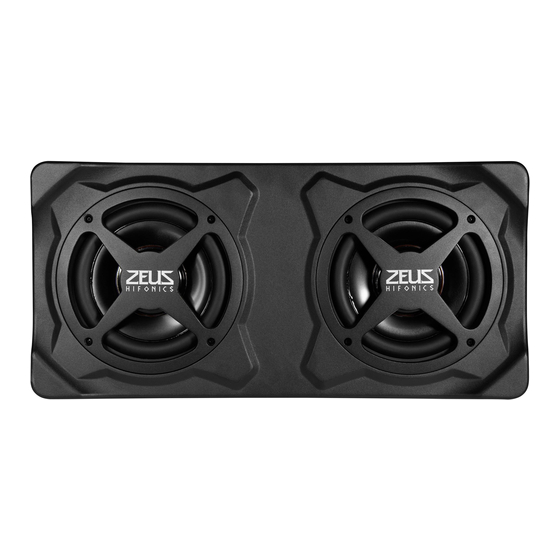Hifonics Zeus ZRX200A Podręcznik użytkownika - Strona 11
Przeglądaj online lub pobierz pdf Podręcznik użytkownika dla Subwoofer Hifonics Zeus ZRX200A. Hifonics Zeus ZRX200A 13 stron.

TROUBLE SHOOTING
If you are having problems after installation follow the trouble shooting procedures below.
Procedure 1:
Check the device for proper connections.
Verify that POWER LED is on. If POWER LED is on skip to Step 3, if not continue.
1. Check the fuse of the device or the external fuse on battery positive cable. Replace if necessary.
2. Verify that Ground connection is connected to clean metal on the vehicle's chassis. Repair/replace if necessary.
Please ensure that you have reconnected the GND connection at the battery after the installation.
3. Verify that there are 9 to 16 Volts present at the positive battery and remote turn-on cable. Verify quality connections for both cables at device,
head unit and battery/fuse holder. Repair/replace if necessary. Check that the vehicle charging system is maintaining proper voltage.
Procedure 2:
PROTECTION LED is on.
1. If the PROTECTION LED is on, this is a sign of driving the device at very high power levels without adequate airflow around the device.
Shut off the system and allow device to cool down. If the previous items do not solve the problem, a fault may be in the device.
Check that the vehicle charging system is maintaining proper voltage.
Procedure 3:
Check the device for a proper audio signal.
1. Verify good RCA input connections at head unit and device. Check entire length of cables for kinks, splices, etc.
Test RCA inputs for AC volts with stereo on. Repair/replace if necessary.
2. Use another audio source for testing to provide an audio signal to the Line Inputs.
Procedure 4:
Check the device for a popping noise while turning on.
1. Disconnect input signal to device and turn device on and off.
2. If the noise is eliminated, check the audio cables and replace them if necessary.
OR
1. Use a different 12 Volt source for REMOTE lead of the device (e.g. battery direct just for testing).
2. If the noise is eliminated, use a different 12 Volt source for REMOTE lead such as the electric antenna
3. Don't connect REMOTE directly to the battery after testing to avoid a discharge of the battery.
Procedure 5:
Check the device if you experience excess Engine Noise.
1. Route all signal carrying wires (RCA, Speaker cables) away from power and ground wires.
OR
2. Bypass any and all electrical components between the head unit and the device. Connect the head unit
directly to input of the device. If noise goes away the unit being bypassed is the cause of the noise.
OR
3. Use another audio source for testing to provide an audio signal to the Line Inputs.
OR
4. Remove existing ground wires for all electrical components. Reground wires to different locations.
Verify that grounding location is clean, shiny metal free of paint, rust etc.
OR
5. Add secondary ground cable from negative battery terminal to the chassis metal or engine block of vehicle.
OR
6. Have alternator and battery load tested by your mechanic. Verify good working order of vehicle electrical system including distributor,
spark plugs, spark plug wires, voltage regulator etc.
11
